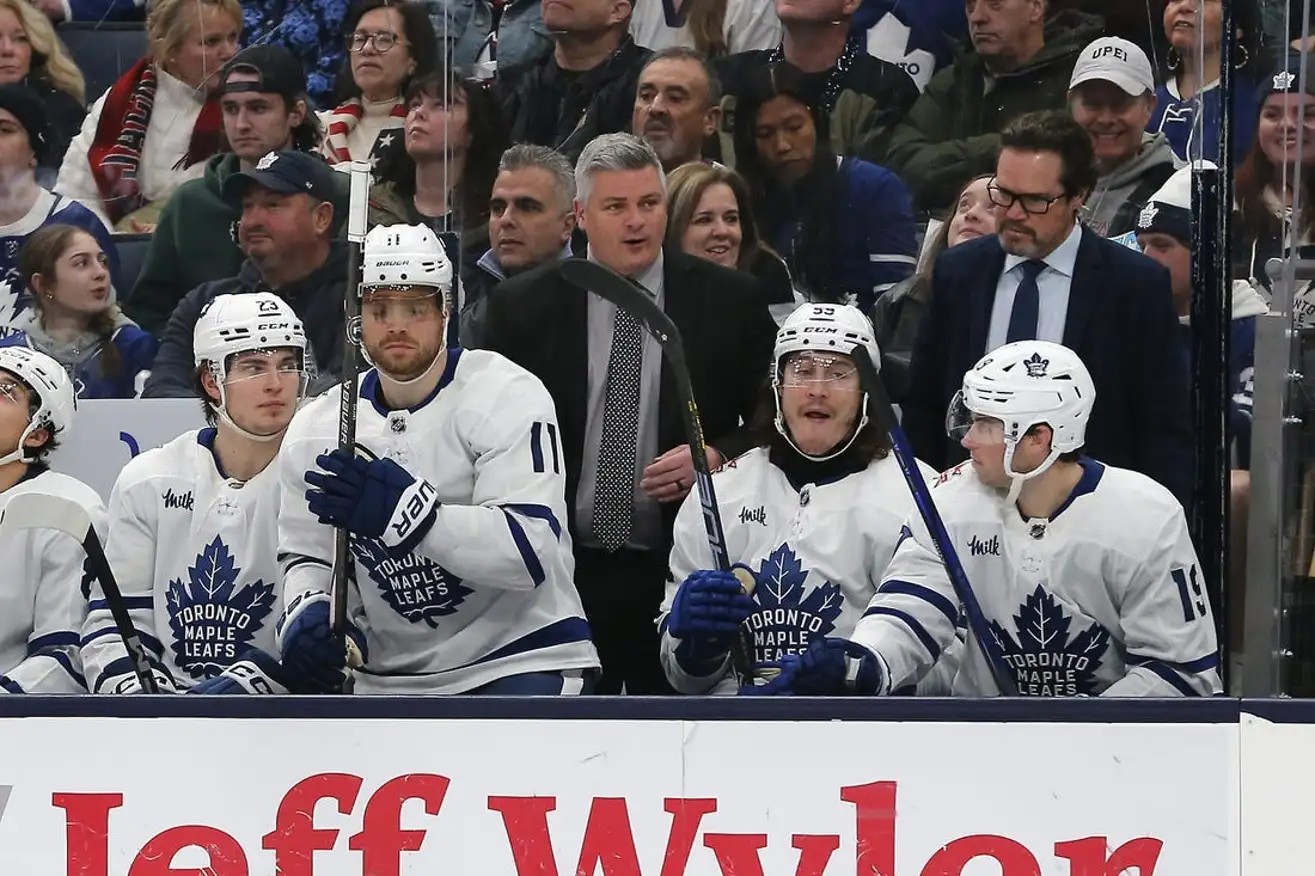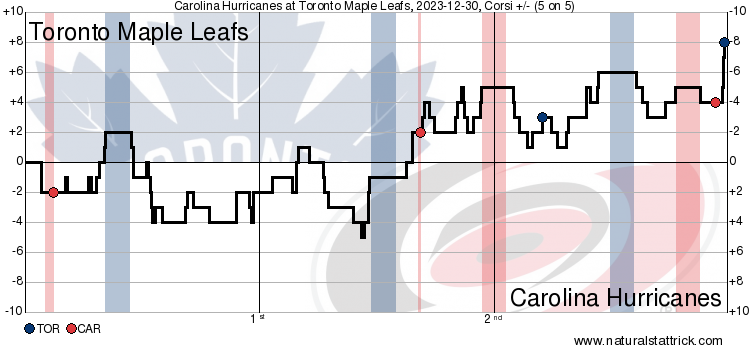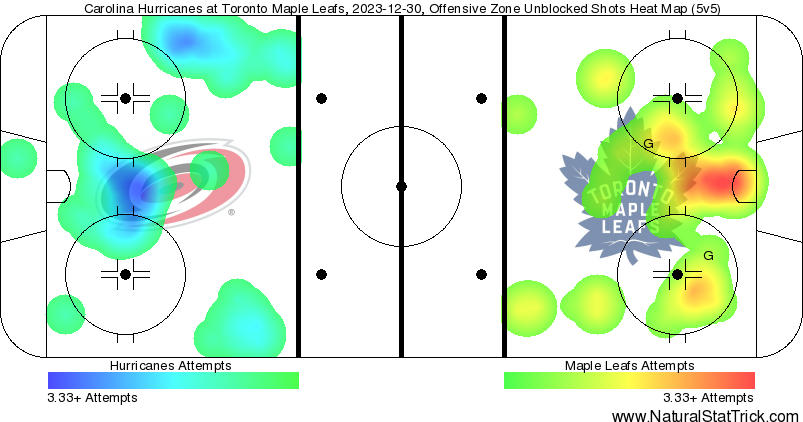One could argue that the healthy scratching of a fourth-line center dominating the storylines in Toronto tonight (and probably the hockey world in general) is typical Leafs fan mania. But there is a broader context to the controversy, and the frustration from sections of the fan base with Sheldon Keefe’s pre-game quotes on Saturday is understandable.
The comments were suspect and the optics weren’t great a few hours later after a 3-2 loss in which Leafs PK conceded twice and the ice-time allocation was eyebrow-raising.
Your game in 10:
1. As far as the actual game goes, it was a “schedule loss” situation against a rested top-end opponent in a tired situation, but the Leafs were competitive and battled throughout. All three periods were fairly evenly played with scoring chances coming at a premium. The Leafs didn’t create enough against Carolina’s committed team defense at five-on-five, couldn’t come close to solving Carolina’s elite PK, and broke down for two power-play goals against which decided the game.
The Leafs created a couple of chances breaking in alone off the rush — one for Matthew Knies in the second period and one for Morgan Rielly in the first; both lacked finishing quality — but they struggled to break through the Canes defense with much frequency. All in all, it felt a little bit like the loss to the Rangers a few weeks ago at the SBA (minus the funky goals against) — there was not much between the teams at five-on-five, and the special teams decided the outcome.
Sheldon Keefe mostly praising the effort after the game didn’t come as a surprise. At five-on-five, the Leafs didn’t give up many free chances in behind the defense, which has clearly been the point of emphasis for the coach of late. The Canes were credited with a total of four high-danger chances at five-on-five, which ties the Leafs’ best mark of the season.
2. It’s going to be overstated how much David Kampf’s absence may have contributed to the PK goals against in this game, although it can’t go completely unmentioned that Kampf is the team’s top forward PK regular alongside Mitch Marner and the Leafs were up against a dangerous power-play unit tonight.
On the 1-0 goal in the first period, coming about 30 seconds into the Carolina PP after a bad penalty by Matthew Knies, Calle Jarnkrok failed to get a puck out on the wall due to a strange bounce off the dasher. Simon Benoit left the front of the net to contest the puck on the backboards and didn’t disrupt the pass out front, and Noah Gregor didn’t react in time to negate the obligatory Michael Bunting goal in his return to T.O.
The second Carolina power-play goal in the second period (after a really soft holding call on Max Domi) came out of nothing after an initial clearance by the Leafs. The Leafs did a good job of not giving up many free looks at five-of-five, but this was definitely a free look on the PK.
On the entry defense, instead of protecting the middle ice before closing off the puck carrier just inside the blue line (thus protecting against the play through the middle and allowing numbers to get back to defend against the in-zone setup), TJ Brodie took a haphazard swing at the puck over by the boards in the neutral zone and couldn’t prevent the pass from getting through. It created a fast-developing odd-man rush type of situation that Jake McCabe and Marner didn’t scramble to defend well at all.
It was just the latest of too many mind-boggling plays and decisions so far this season from Brodie, who was once the perennial Steady Eddy of the Leafs blue line.
3. In the previous three seasons, TJ Brodie played the second most of any Leaf (second to Morgan Rielly) at five-on-five and the Leafs out-scored the opposition by 44 goals in those minutes with strong underlying numbers across the board. He was a +29 in his minutes with Matthews on the ice over those three seasons and a +13 without Matthews on the ice (and still above water in the possession and scoring chance metrics without #34).
This season, Brodie is again the Leafs’ second-most-played player at five-on-five but is a minus-two and is underwater in the possession and xGF metrics. He is a +5 with Matthews on the ice at five-on-five but a -7 without him. Some of it might be due to fewer “checkers” down the Leafs’ lineup and the overall team performance defensively, but Brodie’s quality of play is playing a notable role here.
On the PK, Brodie played the second most on the team outside of Justin Holl between 2020-2023. He went from allowing 6.35 GA/60 and 5.94 xGA/60 on the PK over those three seasons to 8.89 GA/60 and 8.47 xGA/60 so far this season.
Brodie’s quiet game in a big role was easy to take for granted over the years. A big step back from a player counted on so heavily at five-on-five and on the PK is going to be hard felt and it has been so far this year for the Leafs. It started to noticeably slip in the playoffs last spring, and it’s gotten worse through 34 games this season. A reduction in minutes — his TOI is actually up to 21:55/game this season — has to be on the table regardless, but it’s obvious that part of the solution will require additional credible options beyond what is in the organization currently.
4. The positives in the game offensively for the Leafs were the two goals from their third line in the third period and a defenseman getting in on the action offensively.
Five minutes into the third period, Timothy Liljegren scored his first goal of the year and picked up his fourth point in the last five games. At a time when the Leafs needed to start to really push while down 2-0, Liljegren showed good instincts to drift across the zone into space. Max Domi picked him out with a perfect pass off the wall, and the finish from Liljegren was excellent (his shot will catch you by surprise at times).
FIRE THE (LILY) LASER!!! pic.twitter.com/i2ZDZdH7z2
— Toronto Maple Leafs (@MapleLeafs) December 31, 2023
Excluding Morgan Rielly, nine defensemen have appeared in a game for the Leafs this season representing a total of 172 man games played. This was just the fourth goal of the season from those defensemen not named Rielly. Liljegren is now tied for second on the Leafs’ defense in goal-scoring with one.
5. The top line’s shift after the Leafs’ 2-1 goal was not a positive one in terms of building on the momentum. A few minutes after the Liljegren goal, though, the Leafs got an opportunity to tie the game on a power play stemming from a tripping penalty drawn by Noah Gregor.
Gregor’s speed, willingness to get his sweater dirty, and motor to keep his feet moving have helped him draw nine penalties so far this season, which is tied with Marner for the most on the team in around half of the ice time.
While Bunting’s act wore thin on the referees in his second year in Toronto and his penalty differential wasn’t too far above breakeven, he was their most effective player at drawing calls in his time here and drew far more than he took in his first season as a Leaf. The team’s power-play opportunities per game are slightly down from three per game in 2022-23 (18th) to 2.97 per game (25th) so far this season, but Gregor has helped the cause for a Leafs team that has an elite power play but doesn’t get to use it often enough.
6. To me, the Leafs’ power play in the third period was an opportunity to call an audible and switch it up by maybe moving Max Domi onto the top unit; he was starting to really come on with a nice pass for the 2-1 goal and seemed hungry for more (he later laid a big hit and then set up the garbage-time 3-2 goal as well).
I don’t see this as throwing in the towel on the PP just to send a message, either; there is plenty of high-end talent on the top unit and Domi is a high-end passer who has played a ton of PP minutes in the league. Mitch Marner — who really stretched his PP shift earlier in the game to the detriment of the team — continued to struggle with turnovers before taking a penalty himself a few minutes after the Leafs’ PP expired.
7. Part of it was uncharacteristically fighting the puck, but in some ways, this game reminded me of why Marner, in particular, can struggle to impact the game as effectively at five-on-five once inside playoff-style hockey against elite competition.
Facing persistent puck pressure in all three zones — consistent back pressure + tight gaps from the D off the rush, organized layers of d-zone coverage inside the blue line — there is little time and space to curl up, take the extra second in possession, and work the puck through seams east-west. Sometimes Marner just flipped pucks in deep tonight, but when he tried to make plays, there were countless turnovers throughout the game. A tight-checking game against a good defensive team isn’t easy on anybody and few players produce at the same rate in the playoffs as the regular season, but we’ve seen Marner, in particular, struggle to adapt his game in this kind of environment before.
8. After the Sebastian Aho empty-netter all but sealed the result, Nick Robertson scored a consolation goal — off a pretty setup in front of the net by Max Domi — with under 10 seconds left in the game. The final faceoff felt like a borderline troll job by Sheldon Keefe in light of his pre-game “accountability” comments.
The third line created both goals in this game. The power play unit accomplished nothing on the PP or at 6-on-5. Down a goal on a center-ice faceoff with nine seconds to go, the odds of winning the game even with McDavid, Matthews, MacKinnon, Kucherov, Pastrnak, and Makar on the ice would be sub 1%. Keefe still couldn’t bring himself to keep the top group off the ice or maybe reward those who produced in the third period by keeping the other unit on.
9. When I make the point about Marner or another of the team’s star player’s TOI on Twitter or elsewhere, a common rebuttal is that maximizing their minutes maximizes the team’s chances of winning. This is true generally. It goes without saying that if the Leafs played Marner as much or less than their lesser players on a semi-frequent basis, this obviously would hurt the team and would be unwise. But there are nights when your best/most talented players simply aren’t your best players on the ice.
In addition to instilling a real sense of accountability within the team environment, empowering those who are going that night is a “feel” call within a game that a good coach should have in his arsenal when searching for a spark. This isn’t to say Marner should’ve played 14 minutes when chasing the game, but throwing #16 over the boards to continuously throw pucks away in 23+ minutes of TOI is certainly not my idea of “accountability” and also probably wasn’t helping the team win the game tonight.
There reaches a tipping point within a game (and in terms of the individual ice time) where it goes from allowing a really talented player play his way through it while hoping for a difference-making moment of magic, to banging your head against the wall, sending the wrong message to the team, and refusing to reward the more deserving players.
10. I’ll leave you with the following comments from Jon Cooper when he benched an entire line of elite players — Brayden Point, Nikita Kucherov, and Steven Stamkos — for the full third period against Buffalo last season.
“As coaches, you got to put your team in the best position to win. 99.9 percent of the time, those guys give us the best chance to win when they’re on the ice. I just felt for the third period, they weren’t giving us the best chance to win.”
The Lightning were down 4-1 entering the third — they gave up another goal just seconds into the final frame on the PK, making it 5-1 — and Cooper leaned heavily on the likes of Alex Killorn, Brandon Hagel, Nick Paul, and his depth players the rest of the way. Killorn scored twice to make a game of it but Tampa couldn’t erase the four-goal lead. The Lightning lost 6-0 the next night to Carolina while tired in a back-to-back situation but then went on a 5-1-1 run.
It’s pointless to debate whether Tampa maybe could’ve come back in that game with their three stars on the ice, whether it really worked given the team’s 6-0 loss the next night, or if the 5-1-1 turnaround was a sign that the message indeed resonated. But this is a championship coach calling out his multiple-Cups-winning stars and backing it up with reduced ice time.
I’m by no means calling for that sort of drastic action in tonight’s game specifically — merely for Marner not to play 23:13 on a night when he clearly didn’t have it. It is not radical or unheard of for ice time to reflect performance level to some degree, even if star players naturally/rightfully earn more shifts and more leeway. The balance often seems too far out of whack under Keefe.
I’d also argue that scratching Kampf in large part due to an offensive-zone turnover in Columbus (leading a soft tying goal against Samsonov) after playing Marner for 20 minutes in a 9-3 blowout loss in Buffalo — a game in which he caused a goal against by turning the puck over in the defensive zone with a blind between-the-legs pass; he didn’t miss a shift afterward — is not an effective form of accountability.
On the HNIC intermission panel, Kevin Bieksa literally laughed at the idea that this Kampf healthy scratch would “send a message,” which was not an unwarranted reaction. Proper accountability has to start at the top.
































![New Leaf Anthony Stolarz on the opportunity in Toronto: “In Florida, I knew my role as a backup… Now, [Joseph Woll] and I are competing for starts… As a goalie, that’s all you can ask for” Anthony Stolarz, Stanley Cup win, now Maple Leaf](https://mapleleafshotstove.com/wp-content/uploads/2024/07/anthony-stolarz-sc-100x70.jpg)
